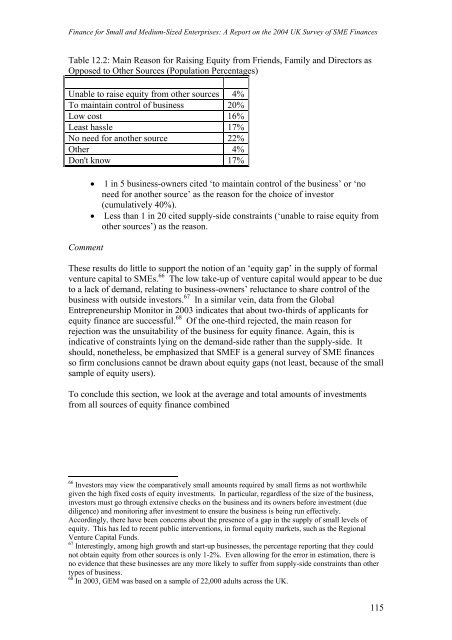Finance for Small and Medium-Sized Enterprises - DTI Home Page
Finance for Small and Medium-Sized Enterprises - DTI Home Page
Finance for Small and Medium-Sized Enterprises - DTI Home Page
You also want an ePaper? Increase the reach of your titles
YUMPU automatically turns print PDFs into web optimized ePapers that Google loves.
<strong>Finance</strong> <strong>for</strong> <strong>Small</strong> <strong>and</strong> <strong>Medium</strong>-<strong>Sized</strong> <strong>Enterprises</strong>: A Report on the 2004 UK Survey of SME <strong>Finance</strong>s<br />
Table 12.2: Main Reason <strong>for</strong> Raising Equity from Friends, Family <strong>and</strong> Directors as<br />
Opposed to Other Sources (Population Percentages)<br />
Unable to raise equity from other sources 4%<br />
To maintain control of business 20%<br />
Low cost 16%<br />
Least hassle 17%<br />
No need <strong>for</strong> another source 22%<br />
Other 4%<br />
Don't know 17%<br />
Comment<br />
• 1 in 5 business-owners cited ‘to maintain<br />
control of the business’ or ‘no<br />
need <strong>for</strong> another source’ as the reason <strong>for</strong> the choice of investor<br />
(cumulatively 40%).<br />
• Less than 1 in 20 cited supply-side constraints (‘unable to raise equity from<br />
other sources’) as the reason.<br />
These results do little to support the notion of an ‘equity gap’ in the supply of <strong>for</strong>mal<br />
66<br />
venture capital<br />
to SMEs. The low take-up of venture capital would<br />
appear to be due<br />
to a la ck of dem<strong>and</strong>, relating to business-owners’ reluctance to share control of the<br />
business<br />
with outside investors.<br />
Entrepre<br />
equity i<br />
reject<br />
indica v <strong>and</strong>-side rather than the supply-side. It<br />
67 In a similar vein, data from the Global<br />
neurship Monitor in 2003 indicates that about two-thirds of applicants <strong>for</strong><br />
nance are successful. 68 f Of the one-third rejected, the<br />
main reason <strong>for</strong><br />
ion was the unsuitability of the business <strong>for</strong> equity finance. Again, this is<br />
ti e of constraints lying on the dem<br />
should, nonetheless, be emphasized that SMEF is a general survey of SME finances<br />
so firm conclusions cannot be drawn about equity gaps (not least, because of the small<br />
sample of equity users).<br />
To conclude this section, we look at the average <strong>and</strong> total amounts of investments<br />
from all sources of equity finance combined<br />
66<br />
Investor s may view the comparatively small amounts required by small firms as not worthwhile<br />
given the<br />
high fixed costs of equity investments. In particular, regardless of the size of the business,<br />
investors<br />
must go through extensive checks on the business <strong>and</strong> its owners be<strong>for</strong>e investment (due<br />
diligence)<br />
<strong>and</strong> monitoring after investment to ensure the business is being run effectively.<br />
Accordingly, there have<br />
been concerns about the presence of a gap in the supply of small levels of<br />
equity.<br />
This has led to recent public interventions, in <strong>for</strong>mal equity markets, such as the Regional<br />
Venture Capital Funds.<br />
67<br />
Interestingly, among high growth <strong>and</strong> start-up businesses, the percentage reporting that they could<br />
not obtain equity from other sources is only 1-2%. Even allowing <strong>for</strong> the error in estimation, there is<br />
no evidence that these businesses are any more likely to suffer from supply-side constraints than<br />
other<br />
types of business.<br />
68<br />
In 2003, GEM was based on a sample of 22,000 adults across the UK.<br />
115















![Joint Report on Social Protection and Social Inclusion [2005]](https://img.yumpu.com/19580638/1/190x132/joint-report-on-social-protection-and-social-inclusion-2005.jpg?quality=85)
